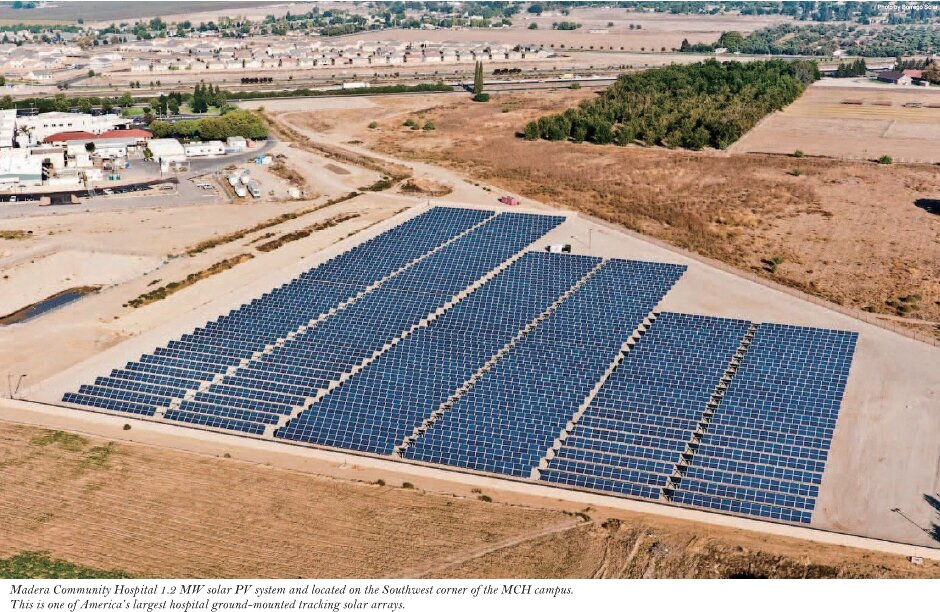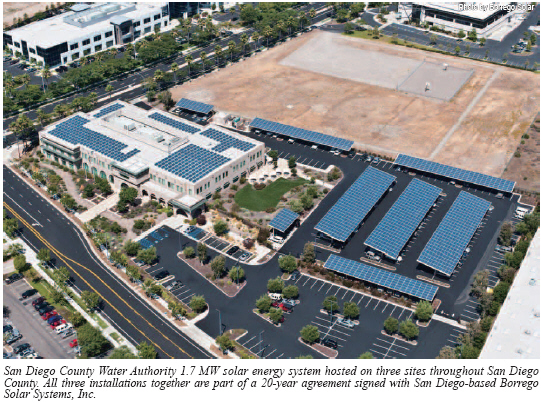By Joseph Harrison

 Over the last 12 years, the solar industry has experienced tremendous growth, moving from the once progressive early adopters to mainstream organizations. Municipalities, federal agencies and other government organizations are strong candidates to go solar, because they have rapidly decreasing budgets, along with often high energy demands and extra land and rooftop space. In 2010, Rhone Resch, President and CEO of the Solar Energy Industries Association, reported that the compound annual growth rate for grid-tied Photovoltaics (PV) from 2000-2009 was 69%. In 2009 alone, grid-tied PV grew 38% in the wake of an economic recovery, alongside a 40% decline in PV module prices. Over the last 12 years, the solar industry has experienced tremendous growth, moving from the once progressive early adopters to mainstream organizations. Municipalities, federal agencies and other government organizations are strong candidates to go solar, because they have rapidly decreasing budgets, along with often high energy demands and extra land and rooftop space. In 2010, Rhone Resch, President and CEO of the Solar Energy Industries Association, reported that the compound annual growth rate for grid-tied Photovoltaics (PV) from 2000-2009 was 69%. In 2009 alone, grid-tied PV grew 38% in the wake of an economic recovery, alongside a 40% decline in PV module prices.
Despite the recent plummet in material and installation costs and the significant long-term savings that solar electric installations generate, the initial investment to get a solar project off the ground can still be cost-prohibitive for many municipalities and government organizations. Since the expiration of the 2012 1603 Treasury Grant, the primary federal financing mechanism is a 30% tax credit. Since public-sector entities are tax-exempt, they can’t take advantage of those funds. That’s why many of those organizations are opting for a Power Purchase Agreement (PPA) to finance solar energy projects. Through a PPA, a third-party investor takes on all finance, design, installation and maintenance costs, and the municipality or government entity agrees to buy the power back, at a fixed and reduced rate. Municipalities enjoy immediate cost-savings and environmental benefits, without paying a dime upfront, while third-party investors bear all financial risk associated with the system, oversee its operations and maintenance, and file the necessary paperwork to state and federal agencies. These investors, usually large financial institutions, are in a much better position to utilize the generous federal tax incentives that come with buying a solar electric system. At the end of the contract, the municipality has the opportunity to renew their contract, purchase the system outright at fair market value, or have the equipment removed completely.
In this article, we take a closer look at a few examples of different municipal projects that were able to benefit from being financed through a PPA.
Landfills
Over the last few years, landfills across the United States have utilized solar PV installations to transform their brownfields into ‘greenfields’. These installations can eliminate energy needs on site or generate energy for neighboring communities and power grids. Beyond helping communities reduce their energy consumption, these projects take a plot of land that was previously written off as barren and transform it into a revenue stream for a municipality’s operation budget. For municipalities looking to reduce their operating costs and transform their stagnant landfills into producers of clean and sustainable energy, solar is a very appealing option.
In Massachusetts, the city of Easthampton’s long-term interest in energy issues played a big part in the decision to install a 2.3 Megawatt (MW) ballasted ground-mount solar array on its capped landfill. Unfortunately, during the feasibility stage of the development process, it was determined that even though there was ample space for a solar array, the historical energy usage at the landfill was too low to make the project pencil out. Fortunately, Massachusetts legislation gave Easthampton the flexibility to apply the energy production from the landfill solar array to any other meter in the same utility zone. With more than enough aggregate energy consumption from other town properties (i.e., school facilities, administrative offices, etc.) an array was designed to maximize the available acreage at the capped landfill making the project an attractive investment for financiers.
Water Districts
With the tremendous cost associated with the treatment and distribution of water, many water districts are going solar to mitigate long-term electricity costs. Given that water authorities are tax-exempt entities, and can’t take advantage of the federal tax benefits, a PPA allows for those tax benefits to be passed to the water authority in the form of a cheaper price per kilowatt-hour. For investors, it’s a low risk investment because it’s readily known that public water treatment, irrigation, and distribution districts will be around to pay the bill in five, ten or twenty years. While going solar makes sense for most water facilities, some are unable to allocate the resources to manage and administer a formal public procurement, meaning their projects might be too small to secure a PPA rate that would make the project worthwhile.
 In order to streamline the vendor selection process, and ensure better buying power, the San Diego County Water Authority (SDCWA) decided to issue a single request for proposals, incorporating the site specifications and energy consumption from ten different water districts and treatment facilities across the county. By administering the public procurement process on behalf of itself and the other districts, SDCWA was able to negotiate the best possible price per kilowatt-hour (PPA rate), and select a single vendor. Once they announced a winner, each of the individual water districts quickly signed PPA contracts and moved on to the construction phase of installing a solar power system on their water tanks, operation centers, and storage facilities. Without the backing of the lager collective, many of the individual water districts would have lacked the resources necessary to properly vet and contract a solar provider. SDCWA installed over a megawatt of solar on top of several water storage structures at its Twin Oaks Valley Water Treatment Plant and two smaller energy systems on the parking lot and roof of its Kearny Mesa headquarters and its Fred A. Heilbron Operation Center in Escondido. In order to streamline the vendor selection process, and ensure better buying power, the San Diego County Water Authority (SDCWA) decided to issue a single request for proposals, incorporating the site specifications and energy consumption from ten different water districts and treatment facilities across the county. By administering the public procurement process on behalf of itself and the other districts, SDCWA was able to negotiate the best possible price per kilowatt-hour (PPA rate), and select a single vendor. Once they announced a winner, each of the individual water districts quickly signed PPA contracts and moved on to the construction phase of installing a solar power system on their water tanks, operation centers, and storage facilities. Without the backing of the lager collective, many of the individual water districts would have lacked the resources necessary to properly vet and contract a solar provider. SDCWA installed over a megawatt of solar on top of several water storage structures at its Twin Oaks Valley Water Treatment Plant and two smaller energy systems on the parking lot and roof of its Kearny Mesa headquarters and its Fred A. Heilbron Operation Center in Escondido.
Community Hospitals
With limited financial resources to spare, PPAs are often the best way for hospitals to incorporate solar into their operating budget and reduce the cost of energy. One common issue is that hospitals and medical facilities are often located in developed areas with limited space. The trick to making a PPA work in this case is to look to more efficient ways to utilize limited space.
The Madera Community Hospital was able to utilize an adjacent plot of land for a PPA agreement to install a ground-mounted 1.2 MW project─one of the few nationwide within a metropolitan city limit to use tracking technologies. With each panel producing its maximizing energy output as they ‘track’ the trajectory of the sun throughout the day, the Madera solar array will replace more than 30% of the hospital’s energy consumption.
When looking to finance a solar power installation, all municipalities should consider PPAs as a viable financing option. PPAs allow public agencies to enjoy the economic, environmental, and marketing benefits of going solar without having to come up with the upfront capital investment or debt financing. With developers not only paying for the system costs up front, but maintaining the operational risk of the systems throughout the life of the contract, PPAs ensure that solar projects get up and running quickly and are producing energy at full capacity over the life of the system.
Joseph Harrison is Senior Project Developer of Borrego Solar (www.borregosolar.com). Harrison joined Borrego Solar in 2008 as a project developer. His focus is on working with customers in the municipal and education sectors to implement comprehensive solar power solutions. Based out of Borrego Solar’s regional headquarters in Lowell, MA, the U.S.A., Harrison has developed Power Purchase Agreements (PPAs) for some of New England’s most progressive municipalities, and largest K12 school districts, universities, community colleges, and private learning institutions. Harrison’s background in the fast-growing Massachusetts’s solar market has made him the leader in solar for landfills, brownfields, and waste management centers. His experience has given him a greater understanding of the technical details associated with permitting for these sites, no-money-down solar financing mechanisms, Solar Renewable Energy Credits (SRECs), and the various incentives and subsidies available to schools and municipalities looking to go solar. Harrison graduated from the University of Massachusetts with a Bachelor’s degree in Business Management.
For more information, please send your e-mails to pved@infothe.com.
ⓒ2011 www.interpv.net All rights reserved.
|



